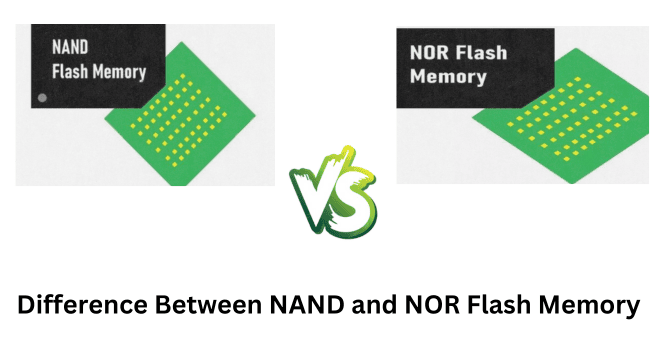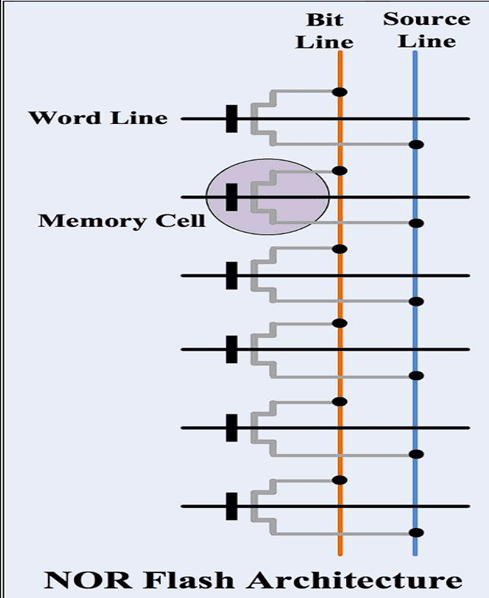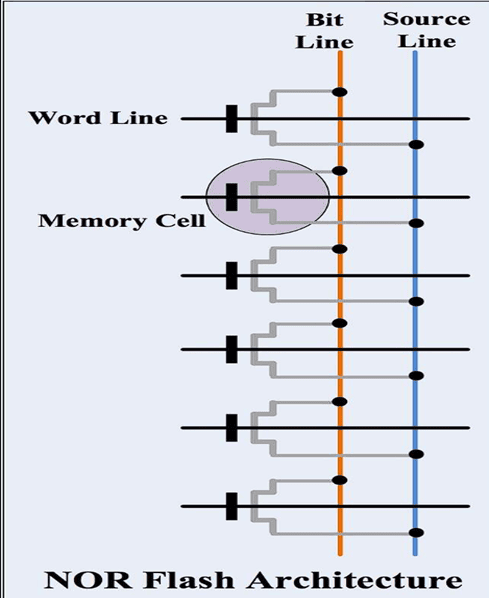
NAND and NOR flash memory are essential non-volatile storage technologies that power many modern devices, from smartphones and USB drives to SSDs and embedded systems. They offer unique advantages, catering to different data storage needs based on performance, cost, and reliability.
NAND flash, known for its high-density storage and low cost, is ideal for applications that require large data volumes and frequent data rewriting, like solid-state drives (SSDs). Meanwhile, NOR flash excels in fast random access and is often used in code storage and bootable environments for devices that demand quick read speeds.
Understanding the differences between NAND and NOR flash is crucial for selecting the right storage solution, as each plays a key role in the efficiency and performance of today’s digital devices.
NOR Flash Memory
NOR flash memory is a type of non-volatile storage technology that retains data even when power is removed, making it ideal for storing code and system firmware in various electronic devices. Developed by Intel in 1988, NOR flash has since become a popular choice in applications that require reliable, fast, and randomly accessible memory.
Working of NOR Flash Memory
NOR flash memory is named for its "Not OR" logic gate configuration, which connects cells in parallel, allowing individual cells to be accessed directly. This architecture provides faster read speeds and direct memory access (DMA), making it an excellent choice for applications needing rapid access to small bits of data, such as boot code or firmware.

Key Features of NOR Flash Memory
Fast Read Times
NOR flash is optimized for quick read speeds, crucial for applications that frequently access stored data.Random Access Capability
NOR’s architecture supports random read and write access, which allows specific data to be accessed independently of the rest of the memory.Reliability and Longevity
With high endurance and the ability to maintain data integrity over thousands of write and erase cycles, NOR flash memory is a reliable choice for applications requiring frequent data access.Low Power Consumption
NOR flash operates at lower power levels, making it a suitable choice for battery-operated devices.
Advantages of NOR Flash Memory
● Excellent random access read speeds
● High reliability and data integrity
● Long lifespan with robust write and erase endurance
Disadvantages of NOR Flash Memory
● Higher cost per bit than NAND flash
● Lower storage density, limiting use in high-capacity applications
NAND Flash Memory
NAND flash memory is a highly efficient type of non-volatile storage that has become the backbone of modern data storage solutions, including SSDs, USB drives, and smartphones. Known for its high-density storage capacity and lower cost per bit compared to other types of memory, NAND flash offers an ideal solution for applications that require large storage volumes, frequent data rewriting, and long-term data retention.
Working of NAND Flash Memory
NAND flash is named after its "Not AND" gate configuration, in which memory cells are connected in a series rather than parallel, as in NOR flash. This structure allows for higher data density and cost efficiency, enabling NAND to store large amounts of data in a compact form. While this architecture slightly limits random access speed, it is highly optimized for sequential data storage, making it perfect for read and write-intensive applications.

Key Features of NAND Flash Memory
High Storage Density
NAND flash can store large amounts of data in a small physical space, making it highly scalable for applications requiring large storage capacities.Cost-Effective
With a lower cost per bit than NOR flash, NAND flash is ideal for consumer products where cost efficiency and storage capacity are priorities.Fast Write and Erase Cycles
NAND flash is optimized for fast, sequential data writing, which benefits devices that require continuous data updates, such as SSDs and memory cards.Long Data Retention
Despite frequent write and erase cycles, NAND flash can retain data for extended periods, contributing to its reliability in long-term storage.
Types of NAND Flash Memory
NAND flash comes in multiple forms to meet different performance and capacity needs:
● Single-Level Cell (SLC)
Stores one bit per cell, offering high speed, reliability, and durability. Used in applications requiring maximum performance.
● Multi-Level Cell (MLC)
Stores two bits per cell, balancing cost and performance. Common in consumer electronics and SSDs.
● Triple-Level Cell (TLC)
Stores three bits per cell, allowing for higher data density at a lower cost, widely used in consumer SSDs and mobile devices.
● Quad-Level Cell (QLC)
Stores four bits per cell, achieving even greater storage density but typically with reduced endurance, suited for data-intensive applications with minimal write cycles.
Advantages of NAND Flash Memory
● High storage density, allowing large data volumes in small form factors
● Cost-effective, especially for large-capacity applications
● Fast sequential read and write speeds
Disadvantages of NAND Flash Memory
● Slower random access speeds compared to NOR flash
● Lower endurance in multi-level cells (MLC, TLC, QLC) compared to single-level cell (SLC)
Difference Between NAND and NOR Flash memory
Features | NAND Flash Memory | Nor Flash Memory |
Memory architecture | Organized in series ("Not AND" configuration); cells are arranged in a string of transistors. | Organized in parallel ("Not OR" configuration); cells are individually accessible. |
Access Speed | Optimized for fast sequential read/write speeds; slower in random access. | Faster random access speeds, ideal for direct code execution and read-only applications. |
Cost | Lower cost per bit, making it more cost-effective for high-capacity storage. | Higher cost per bit due to lower storage density; generally more expensive for high capacity. |
Data Retention | Retains data effectively for long-term storage, though this can vary with cell type (SLC, MLC, etc.). | Reliable data retention, often with a longer lifespan than NAND for code storage. |
Endurance | Lower endurance in higher-density cells (MLC, TLC, QLC); SLC versions offer better endurance. | Higher endurance with fewer write/erase limitations, making it ideal for frequently accessed code. |
Power Consumption | Generally lower power consumption, suitable for mobile and battery-powered devices. | Requires more power, especially during random access, so it’s less power-efficient. |
Storage Capacity | Higher storage capacity in smaller physical form, optimized for bulk data storage applications. | Lower storage capacity; best for code storage and applications needing fast, random access. |
Application | SSDs, USB drives, SD cards, smartphones, tablets, data center | Firmware storage, embedded systems, microcontrollers. |
How to Choose Between NAND and NOR Flash Memory
Selecting the right flash memory type, whether NAND or NOR, depends on your application's storage requirements, performance needs, and budget. Here are the critical factors to consider when deciding between NAND and NOR flash memory:
1. Data Access Patterns
● Choose NAND Flash if your application involves sequential data read/write operations, such as those found in data storage applications like SSDs or media storage in smartphones. NAND’s architecture is designed for fast, sequential access, making it ideal for handling large data volumes efficiently.
● Choose NOR Flash if your application requires random data access for executing code directly from memory, such as in embedded systems or firmware storage. NOR flash excels in direct code execution due to its fast random read capability.
2. Storage Capacity Needs
● Select NAND Flash when you need high storage capacity at a low cost, as it supports higher data density, which is ideal for large-scale storage devices like USB drives and data center SSDs.
● Opt for NOR Flash when lower storage capacity suffices, especially if the memory is primarily used for storing firmware, boot loaders, or small amounts of critical data in IoT or automotive applications.
3. Read and Write Speed Requirements
● NAND Flash offers fast sequential write and erase speeds, making it ideal for applications needing rapid data storage and retrieval, like digital media storage.
● NOR Flash provides quick random access speeds, making it perfect for applications needing fast data retrieval without reading an entire block. This characteristic is essential in bootable systems and real-time applications that require immediate data access.
4. Cost Considerations
● NAND Flash has a lower cost per bit due to its higher density, making it more budget-friendly for high-capacity applications.
● NOR Flash has a higher cost per bit due to its parallel cell structure, typically making it more expensive in high-density capacities. It’s best for applications where fast access is critical and storage capacity needs are lower.
5. Data Retention and Endurance
● Choose NAND Flash if your application requires long-term data retention and high storage density. For maximum endurance, Single-Level Cell (SLC) NAND is a good choice, especially in applications needing frequent write/erase cycles.
● Choose NOR Flash for applications where data integrity and endurance are paramount, particularly in scenarios with lower write cycles but frequent read access, such as embedded firmware storage.
6. Power Consumption
● NAND Flash is often more power-efficient, which is an advantage in mobile and battery-operated devices where reducing power consumption is critical.
● NOR Flash may consume more power, especially in random access, making it less suited for low-power applications but a strong option for devices that stay connected to a power source.
7. Application Requirements
● Choose NAND Flash for data storage-heavy applications such as SSDs, USB drives, and large-scale storage in smartphones and data centers where high capacity, cost efficiency, and sequential performance are crucial.
● Choose NOR Flash for code storage and direct execution in embedded systems, microcontrollers, automotive electronics, and IoT devices that rely on quick boot times and immediate data access.
Conclusion
In conclusion, NAND and NOR flash memory each offer unique advantages that make them ideal for specific applications. NAND flash stands out for its high storage density, cost efficiency, and rapid sequential data access, making it perfect for consumer electronics, SSDs, and data centers requiring large data volumes.
NOR flash, on the other hand, provides fast random access, high reliability, and endurance in critical applications like firmware storage, embedded systems, and automotive electronics. When deciding between NAND and NOR flash memory, consider your application’s storage capacity, access speed, endurance, and budget requirements.
Understanding these key differences helps in selecting the best flash memory solution for optimal performance and longevity in your devices.
FAQs on NAND Vs NOR Flash Memory
1. Can NOR and NAND flash be used together in a system?
ANS . Yes, NOR and NAND flash can be used together in a system, with NOR typically storing firmware or boot code for quick access and NAND handling bulk data storage efficiently.
2. Can I replace NOR flash with NAND flash in my system?
ANS. In most cases, NOR flash cannot be directly replaced with NAND flash because they have different architectures and access speeds; NOR is better suited for code execution and quick random access, while NAND is optimized for high-density data storage.
3. How do NAND and NOR flash memories affect boot time in embedded systems?
ANS. NOR flash typically improves boot time in embedded systems due to its fast random access, allowing code to execute directly from memory, while NAND flash may require loading data into RAM first, potentially slowing down the boot process.
